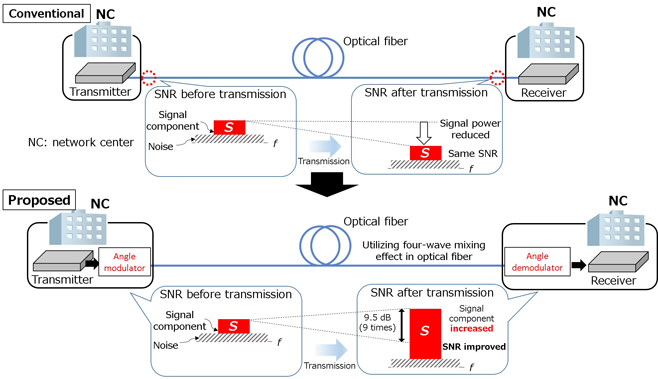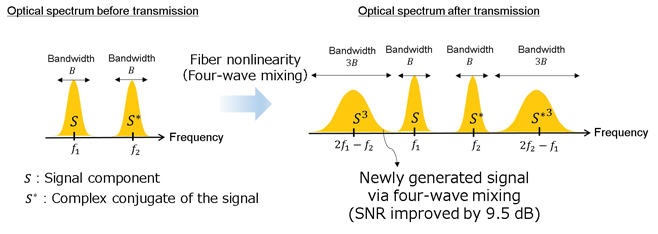 Print
Print
- Advanced Technology Laboratories
Development of a new transmission method for nine-fold improvement of optical fiber signal-to-noise ratio
~For a resilient optical fiber communication network in the Beyond-5G/6G Era~
July 26, 2021
KDDI Research, Inc.
Using the four-wave mixing (FWM) phenomenon that occurs in optical fibers (Note 1), KDDI Research, Inc. (Head office: Fujimino, Saitama; referred to as “KDDI Research” herein) developed and successfully tested a new transmission method to improve the input signal-to-noise ratio (SNR) of optical signal components of an optical fiber by nine times after transmission. The SNR in existing transmission methods does not increase; it either remains the same or decreases because of signal degradation. However, the revolutionary invention presented herein can drastically improve the SNR after transmission and increase the transmission capacity by approximately three times more than conventional methods can (e.g., increase capacity from that of a quadrature phase shift keying (QPSK) signal to that of a 64-quadrature amplitude modulation (64-QAM) signal (Note 2)). Therefore, we expect it to be adopted as the technological basis for the expansion of the optical fiber communication transmission capacity, which will support Beyond-5G/6G Era networks.

Fig. 1—Overview of the new transmission method
【Background】
In the futuristic communication concept of “Beyond 5G/6G Era” envisioned by researchers, the present volume of data traffic through the communication networks will increase significantly. To address this phenomenon, the system performance metrics of optical fiber networks supporting communication networks, such as their transmission capacity and distance, will require considerable improvement over the subsequent decades. The existing method for increasing the capacity of optical fiber communication networks involves overlaying information on a single optical signal. However, this requires the SNR of optical signal components to be expanded according to the volume of overlaid information. If this is not possible, the transmission distance must be reduced. Therefore, it is believed that a new transmission method will be developed that can dramatically increase the optical signal components after transmission.
【Research results】
By applying a nonlinear optical effect (FWM), we at KDDI Research developed a transmission method that improves the SNR of the optical signal components of the optical fiber by nine times after transmission; this was verified using optical signals that will presumably be used in the Beyond-5G/6G Era. The principle used and experimental results of the proposed transmission method are as follows.

Fig. 2—Principle for improving SNR by nine times
・Method and principle: If two optical signals—signal 1 (frequency f1) and signal 2 (frequency f2), where signal 2 is the complex conjugate of signal 1 (Note 3), are fed to the optical fiber for transmission, resulting optical signals of frequencies (f1×2) - f2 and (f2×2) - f1, with optical SNR nine times larger than that of the original signals, are obtained.
・Experimental results: The zero-dispersion wavelength of the optical fiber was set to a value between c/f1 and c/f2, where c represents the speed of light. Furthermore, angle modulations, such as radio frequency modulation (FM), were applied to the optical signal. As a result, optical signal components with optical SNRs approximately nine times larger than that of the original components were detected (that is, the noise was reduced to one-ninth of that in the original signal).
These results were presented as a post-deadline paper (Note 4) at the Optical Communication Conference & Exposition (OFC 2021), held between 6th and 11th June, 2021, the world’s largest academic conference in the field of optical communications that presents the latest results of highly valued research.
【Visions for the Future】
To prepare for the Beyond-5G/6G Era, we will continue to promote research and development (R&D) in optical transmission technologies toward building greater capacities to meet the requirements of future data communication.
■ KDDI Research’s initiatives
KDDI and KDDI Research formulated “KDDI Accelerate 5.0”, the concept of a next-generation society envisioned for 2030. The paper “Beyond 5G/6G White Paper” summarized how this society can be realized in terms of the “Future Image” and “Technologies” required to create an ecosystem that spurs innovation. To develop a new lifestyle, the two companies will continue to invest in R&D concerning seven different technologies and an orchestration technology that links them. The results presented here pertain to one of these seven technologies, “Network.”
(Note 1) Nonlinear optical effect
This is a general term for the phenomenon that occurs when light enters a material and generates another light wave with a frequency different from that of the incident light. For this experiment, the FWM nonlinear optical effect was used, in which two light waves of different frequencies are generated from the two original light waves.
(Note 2) QPSK and 64-QAM signals
QPSK signal: A modulation method that can send two bits of information per symbol.
64-QAM signal: A modulation method that can send six bits of information per symbol.
(Note 3) Complex conjugate
The offset of the time-interval at which a light wave vibrates, defined by the state of the wave, is called phase. In communication, phase modulation is a method of expressing information with the phase of the carrier wave. The complex conjugate of a signal can be defined as a signal with a phase that is the inverse of the original phase-modulated signal.
(Note 4) Post-deadline paper
A paper received after the general paper submission deadline is a post-deadline paper. Such papers are selected during the conference, and only highly-rated research results are presented.
Paper information: S. Ishimura et al., “Enabling Technology for 9.5-dB SNR Enhancement Utilizing Four-Wave Mixing Between a Conjugate Pair of Angle Modulation for Analog Radio-over-Fiber Links,” OFC2021, F3C.3, (2021).
※The information contained in the articles is current at the time of publication.Products, service fees, service content and specifications, contact information, and other details are subject to change without notice.